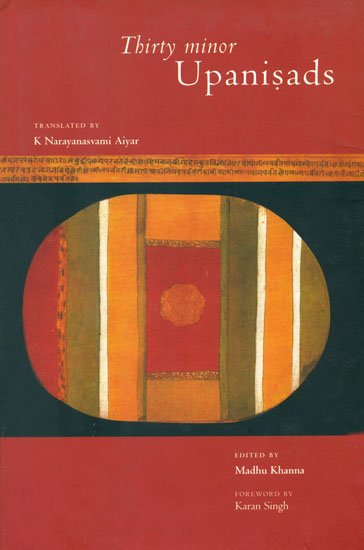Thirty minor Upanishads
by K. Narayanasvami Aiyar | 1914 | 95,228 words
This book contains the English translation of thirty minor Upanishads.—Fourteen belonging to Vedanta, two are categorised as Physiological, three are Mantra, two are Sannyasa and the remaining nine are categorised as Yoga-Upanishads. These Upanishads are properly defined as the Aranya-portion of the Vedas (most ancient Hindu scriptures) and are so-...
Paingala Upanishad of Shukla-Yajurveda, Chapter I
Om. Paiṅgala, having served under Yājñavalkya for twelve years, asked him to initiate him into the supreme mysteries of Kaivalya. To which Yājñavalkya replied thus: "O gentle one, at first, this (universe) was Sat (Be-ness) only. It (Sat) is spoken of as Brahman which is ever free (from the trammels of matter), which is changeless, which is Truth, Wisdom, and Bliss, and which is full, permanent, and one only without a second. In It, was like a mirage in the desert, silver in mother-of-pearl, a person in the pillar, or colour, etc., in the crystals, mūlaprakṛti, having in equal proportions the guṇas, red,[1] white, and black, and being beyond the power of speech. That which is reflected in it is Sākṣi-Caitanya (lit., the witness-consciousness), It (mūlaprakṛti) undergoing again change becomes with the preponderance of Sattva (in it), Āvaraṇa[2] Śakti named avyakta. That which is reflected in it (Avyakta) is Īśvara-Caitanya. He (Īśvara) has Māyā under his control, is omniscient, the original cause of creation, preservation, and dissolution, and the seed of this universe. He causes the universe which was latent in Him, to manifest itself through the bonds of karma of all creatures like a painted canvas unfurled. Again through the extinction of their karmas, he makes it disappear. In Him alone is latent all the universe, wrapped up like a painted cloth. Then from the supreme (Āvaraṇa) Śakti, dependent on (or appertaining to Īśvara, arose, through the preponderance of Rajas, Vikṣepa[3] Śakti called Mahat. That which is reflected in it is Hiraṇyagarbha-Caitanya. Presiding (as He does) over Mahat, He (Hiraṇyagarbha) has a body, both manifested and unmanifested.[4] From Vikṣepa Śakti, of Hiraṇyagarbha arose, through the preponderance of Tamas, the gross Śakti called ahaṅkāra. That which is reflected in it is Virāt-Caitanya. He (Virāt) presiding over it (ahaṅkāra) and possessing a manifested body becomes Viṣṇu, the chief Puruṣa and protector of all gross bodies. From that Ātmā arose ākāś; from ākāś arose vāyu, from vāyu agni, from agni apas, and from apas pṛthivī. The five tanmātras[5] (rudimentary properties) alone are the guṇas (of the above five). That generating cause of the universe (Īśvara) wishing to create and having assumed tamo-guṇa, wanted to convert the elements which were subtle tanmātras into gross ones. In order to create the universe, he divided into two parts each of those divisible elements; and having divided each moiety into four parts, made a fivefold mixture, each element having moiety of its own original element and one-fourth of a moiety of each of the other elements, and thus evolved out of the fivefold classified gross elements, the many myriads of Brahmāṇḍas (Brahma's egg or macrocosm), the fourteen worlds pertaining to each sphere, and the spherical gross bodies (microcosm) fit for the (respective) worlds. Having divided the Rajas-essence of the five elements into four parts, He out of three such parts created (the five) prāṇas having fivefold function. Again out of the (remaining) fourth part, He created karmendriyas (the organs of action). Having divided their Sattva-essence into four parts, He out of three such parts created the antaḥkaraṇa (internal organ) having fivefold function. Out of the (remaining) fourth part of Śattva-essence, he created the jñānendriyas (organs of sense). Out of the collective totality of Sattva-essence, He created the devatās (deities) ruling over the organs of sense and actions. Those (devatās) He created, He located in the spheres (pertaining to them). They through His orders, began to pervade the macrocosm. Through His orders, Virat associated with ahaṅkāra created all the gross things. Through His orders, Hiraṇyagarbha protected the subtle things. Without Him, they that were located in their spheres were unable to move or to do anything. Then He wished to infuse cetana (life) into them. Having pierced the Brahmāṇḍa (Brahma's egg or macrocosm) and Brahmarandhras (head-fontanelle) in all the microcosmic heads, He entered within. Though they were (at first) inert, they were then able to perform karmas like beings of intelligence. The omniscient Īśvara entered the microcosmic bodies with a particle of Māyā and being deluded by that Māyā, acquired the state of diva. Identifying the three bodies with Himself, He acquired the state of the actor and enjoyer. Associated with the attributes of the states of jāgrat, svapna, suṣupti, trance, and death and being immersed in sorrow, he is (whirled about and) deluded like water-lift or potter's wheel, as if subject to birth and death."
